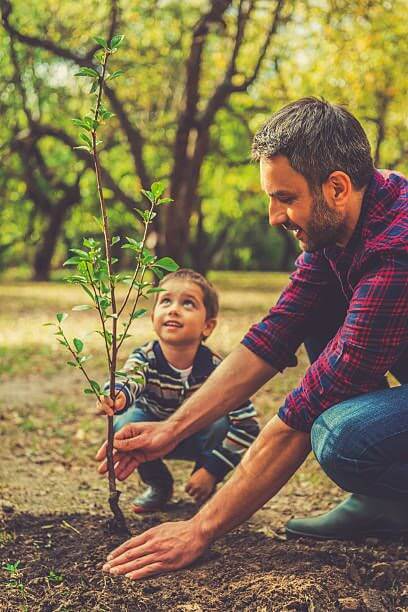Introduction
Planting trees might seem like a simple act, but it carries profound importance for the environment, society, and even the economy. Trees are more than just a source of shade or a boost to property aesthetics—they are vital to our planet’s health and our own well-being.
Why Tree Planting is Essential
Environmental Impact
Trees play a critical role in maintaining the ecological balance. They take in carbon dioxide, emit oxygen, and contribute to reducing the impact of climate change.

Climate Change Mitigation
Trees are natural carbon sinks. They absorb carbon dioxide from the atmosphere and store it, which helps to reduce the overall concentration of greenhouse gases.This mechanism, referred to as carbon sequestration, is crucial for lessening the impacts of climate change.
Biodiversity Support
By planting trees, we create habitats for various species of flora and fauna. This supports biodiversity, ensuring the survival of numerous species that might otherwise be at risk of extinction.
Environmental Impact of Trees
Air Quality Improvement
Trees act as natural air filters. They absorb pollutants like sulfur dioxide, ammonia, and nitrogen oxides from the air. This significantly improves the air quality, especially in urban areas where pollution levels are high.
.
Water Cycle Regulation
Trees are vital to the water cycle, taking up water through their roots and releasing it into the air via transpiration. This helps to maintain moisture levels in the environment and can influence local weather patterns.
Climate Change Mitigation
Carbon Sequestration
As trees grow, they absorb and store carbon dioxide. This process helps to offset emissions from human activities, such as burning fossil fuels. Mature trees can store significant amounts of carbon, making them powerful tools in the fight against climate change.
Reducing the Urban Heat Island Effect
Urban areas tend to be warmer than their rural surroundings due to human activities and infrastructure. Trees provide shade and release moisture into the air through transpiration, which helps to cool these areas down.
Providing Shade and Cooling
Trees offer natural cooling by providing shade. This not only reduces the need for air conditioning but also creates more comfortable outdoor environments, encouraging people to spend time outside.
Supporting Biodiversity
Habitat Creation
Planting trees creates habitats for countless species. Birds, insects, mammals, and even other plants depend on trees for food, shelter, and breeding grounds.
Supporting Wildlife
Trees are integral to the survival of many wildlife species. They provide nesting sites, food sources, and protection from predators, thus supporting a diverse range of animal life.
Enhancing Ecosystems
By fostering diverse plant and animal communities, trees enhance the overall health and resilience of ecosystems. This biodiversity is crucial for the stability and functionality of natural environments.
Social and Economic Benefits
Improving Mental Health and Well-being
Spending time around trees and nature has been shown to reduce stress, anxiety, and depression. Green spaces encourage physical activity, social interaction, and a sense of community, all of which contribute to mental well-being.
Boosting Local Economies
Tree planting can stimulate local economies by creating jobs in landscaping, maintenance, and tourism. Additionally, well-placed trees can reduce energy costs by providing shade and windbreaks, which lower heating and cooling expenses.
Increasing Property Values
Properties with trees and well-maintained landscapes generally have higher market values. Trees add aesthetic appeal and can make neighborhoods more attractive, increasing the overall desirability of an area.
Choosing the Right Tree
Native vs. Non-native Species
When choosing trees to plant, it’s essential to consider whether they are native to the area. Native species are adapted to local conditions and support local wildlife, while non-native species can sometimes become invasive and disrupt local ecosystems.

Planning Your Tree Planting Project
Setting Goals and Objectives
Define the goals of your tree planting project. Are you aiming to create shade, improve air quality, support wildlife, or simply enhance the landscape?Having well-defined goals will steer your planning process.
Site Selection and Preparation
Choose a suitable site for planting. Ensure the location has enough space for the tree to grow to its full size without interfering with buildings, power lines, or other infrastructure. Prepare the soil by removing weeds and ensuring it is well-aerated.
Involving the Community
Engage the community in your tree planting project. This can include organizing planting events, educating residents about the benefits of trees, and encouraging local businesses and schools to participate.
How to Plant a Tree Correctly
Preparing the Site
Begin by excavating a hole twice the width and the same depth as the tree’s root ball. This facilitates easier root expansion and establishment.
Planting Techniques
Position the tree in the hole, making sure it is upright. Back fill with soil, pressing it lightly to remove any air gaps. Water the tree thoroughly after planting.
Watering and Care After Planting
Newly planted trees need regular watering to help them establish roots. Ensure thorough and regular watering, particularly in dry spells. Apply mulch around the tree’s base to maintain moisture levels and stabilize soil temperature.
Tree Maintenance
Pruning and Trimming
Regular pruning helps trees grow strong and healthy. Remove dead or damaged branches to prevent disease and promote new growth. Proper trimming also helps to shape the tree and maintain its structure.
Pest and Disease Management
Monitor trees for signs of pests and diseases. Timely identification and intervention are essential to avoid significant harm. Employ Eco-friendly pest management techniques whenever feasible.
Mulching and Fertilizing
Mulch helps to retain soil moisture, suppress weeds, and regulate soil temperature. Fertilize trees as needed to provide essential nutrients, but avoid over-fertilization which can harm the tree and the environment.
Common Challenges in Tree Planting
Dealing with Poor Soil Conditions
Improving soil quality can be challenging but is essential for healthy tree growth. Amend soil with compost or other organic matter to improve its structure and nutrient content.
Protecting Young Trees from Damage
Young trees are vulnerable to damage from animals, lawn equipment, and harsh weather. Use tree guards or fencing to protect them until they are established.
